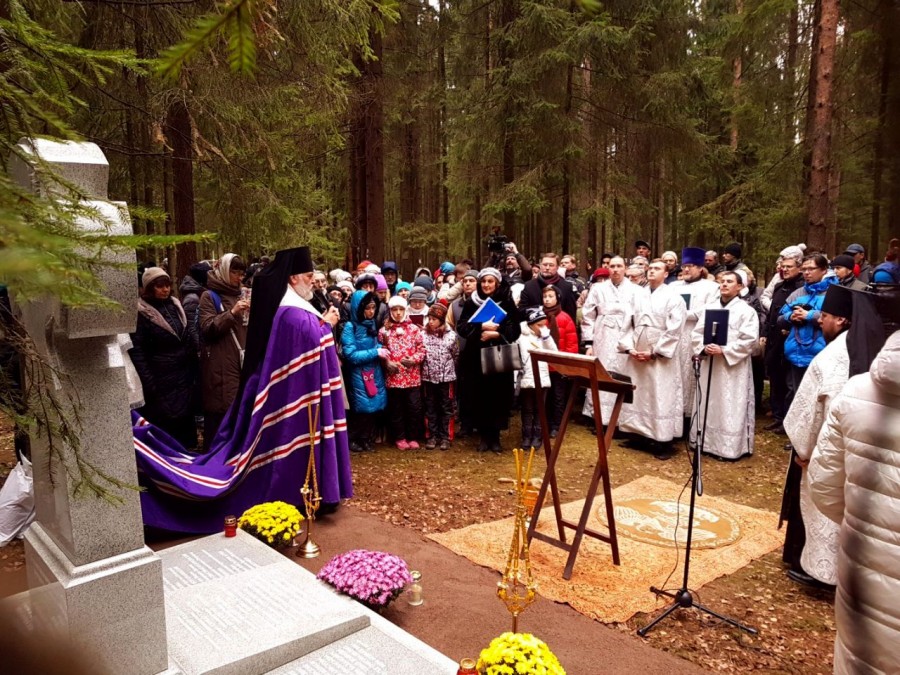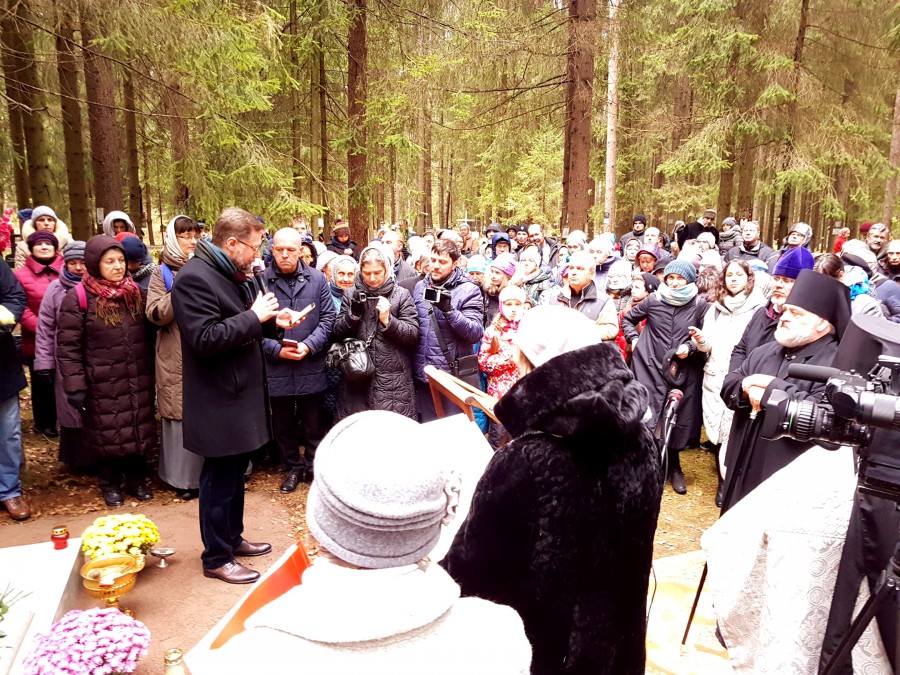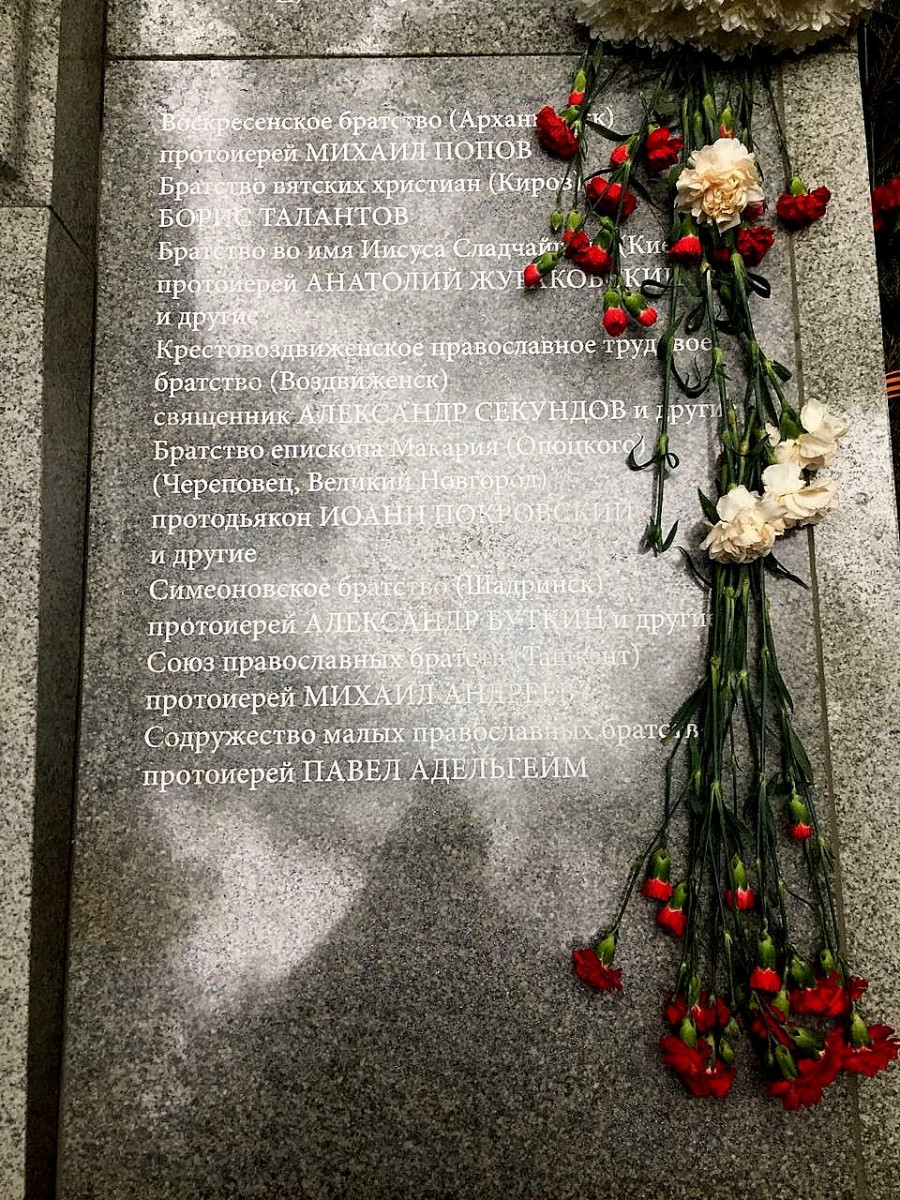First-Ever Monument to Orthodox Brotherhoods is Unveiled in St. Petersburg
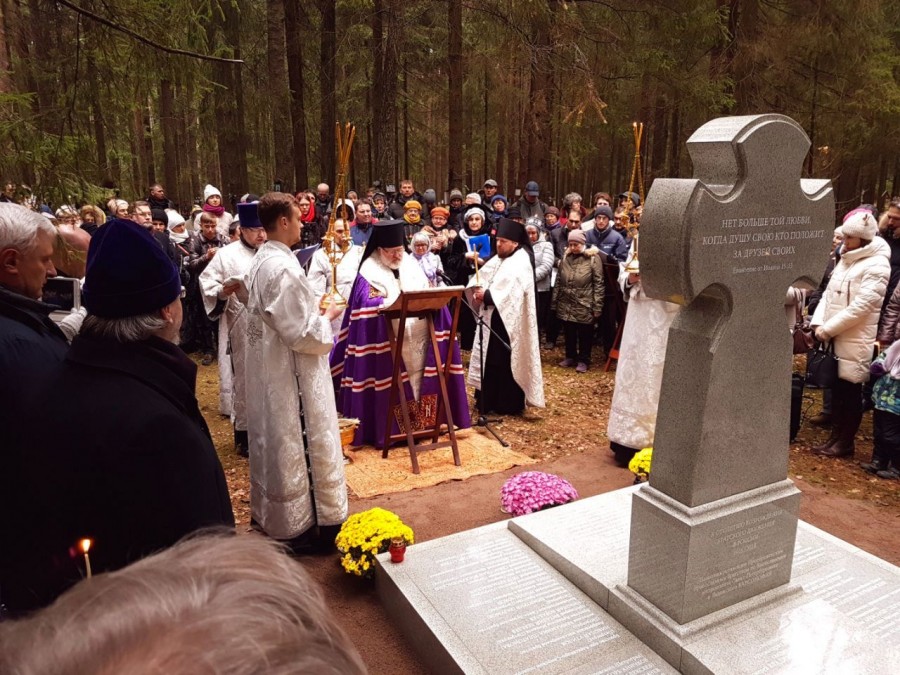
Diocesan Suffragan Bishop Nazar of Kronstad led the ceremony at the monument’s unveiling, thanking the Transfiguration Brotherhood for their initiation of the monument project, and reminding those gathered that next year we celebrate the 100th anniversary of the creation of the Alesander Nevsky Brotherhood, just as this year “we mark the 100th anniversary of the great tragedy which took place in October and November 1917 and changed the course of world history.” “This isn’t just something that happened 100 years ago,” he said, “but something that is still taking place today and which will, long into the future, have a real effect upon all of us.”
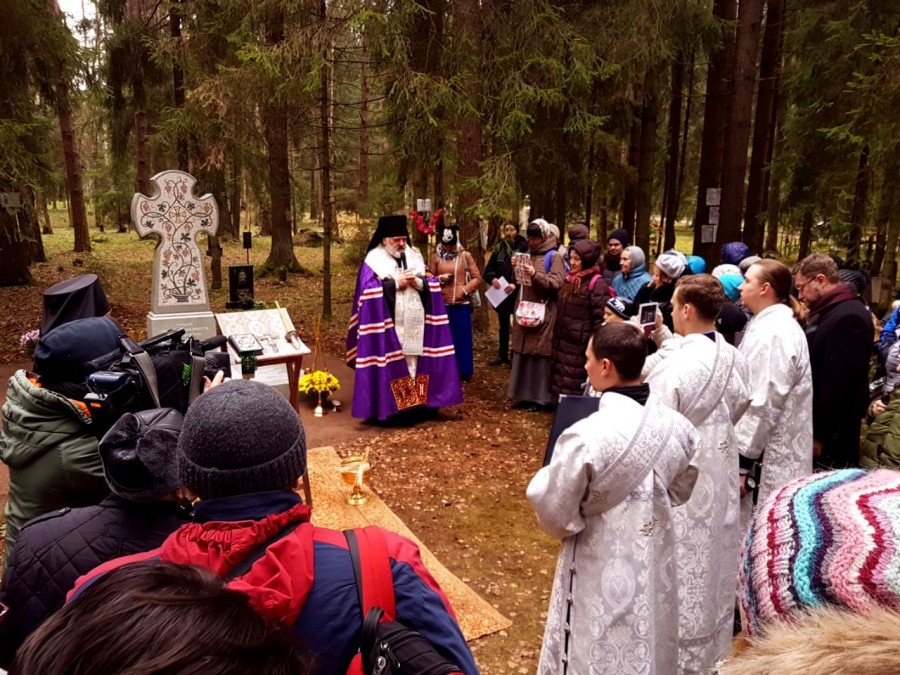
On behalf of those who initiated the monument, Yulia Balakshina, Chairman of the Minor Brotherhood of St. Peter, welcomed those who had gathered for the monument’s unveiling.
Dmitry Gasak, Chairman of the Transfiguration Brotherhood, which initiated the monument project, said that “Christians should not only look back into history and remember that which has happened, but also strive to be bearers of that spirit of Christ’s life which united those brothers and sisters of the Orthodox Christian brotherhoods existing in those most difficult times of Russian history. This is the all-important goal which stands before us today.”
Gasak also passed on the greetings of the founder of the Transfiguration Brotherhood, Fr. Georgy Kochetkov, who said, “We have strayed so far from the “norm” for church life, that we have forgotten about the great tradition of living as brothers and sisters in Christ, in brotherhood, in brotherly love and fellowship in brotherhoods and Christian communities. For this reason, the blessing of a cross in honour of these holy brothers and sisters is not only a remembrance of these great people, who are capable of inspiring us all, but also a remembrance of that rule of life for which we should strive – or, more precisely – which we should live out, in imitation of the example of these saints.”
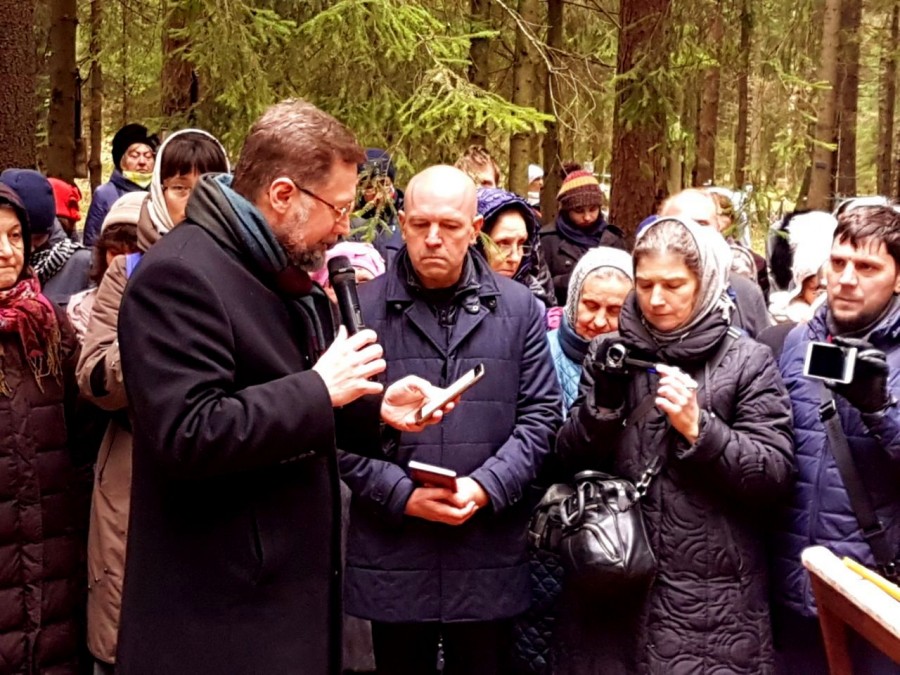
More than 45 thousand people are buried in the Levashovo Cemetery, although their burial here was only made known 50 years after it occurred – after Perestroika. In 1937 and 1938, the bodies of those who were executed by firing squads in Leningrad, as a result of orders received from Moscow, were secretly buried here. Similar burial grounds can be found near the administrative centres of nearly all of the major cities of our country, but “Levashovskaya Pustinj”, as it is called, is the largest and most well-known.
“In this, the 100th year since Russian history was turned upside down, since the beginning of the Red-Leninist Terror, and the 80th year since the beginning of the Great Stalinist Terror, we have erected and blessed this wonderful monument in this place,” said Anatoly Razumov, the author of a Leningrad Martyrology and Director of the Names Returned Centre (Vozvraschyonniye Imena).
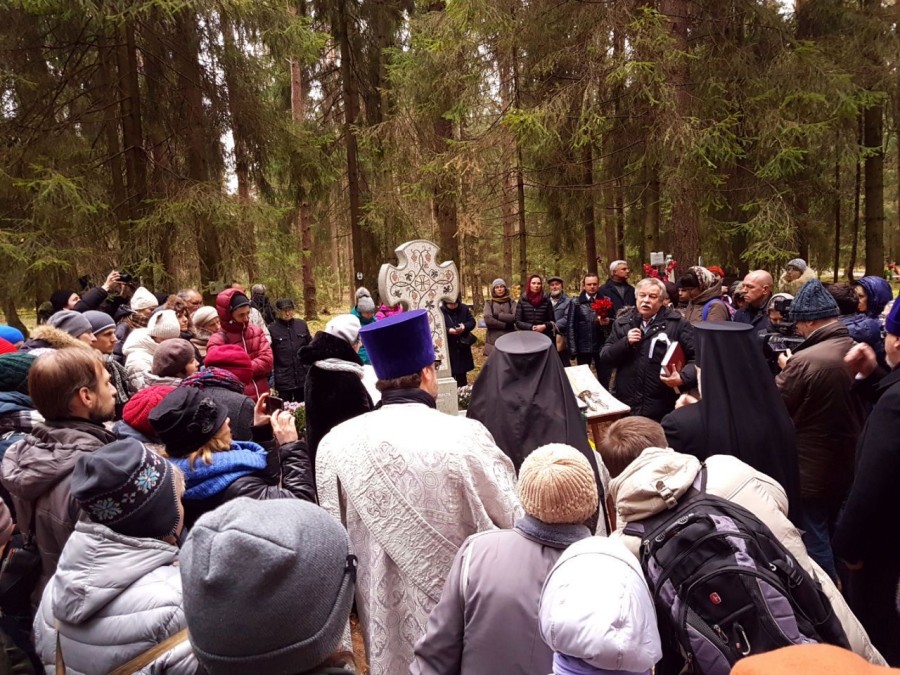
The new monument was designed by Elena Alexandrova and architect Inna Verzhbitskaya, and perpetuates the memory of some very specific people, who were active in their faith, trying to be the conscience of Russia during the years of Soviet repression, living together in the depth of Christian freedom, faith and truth – unmoved by fear of death, mockery or humiliation.

Some members of Orthodox Christian Brotherhoods are indeed buried in the Levashovo Cemetery, though in the majority of cases the factual location of their burial is impossible to establish: many died in settlements in exile, in prisons and in the prison camps of the GULAG. They were murdered – sharing the fate of many, many other victims – and are buried in paupers graves, the locations of which are unknown to this day.
During the years of Soviet repression, when churches and monasteries were turned into prisons and grounds for firing squads, it was Orthodox brotherhoods in particular, which remained the secret channel of living water – of the church’s “full and native” life – as the members of the well-known Moscow-based brotherhood of Archimandrite Sergei (Savyolev) called them.
Historians believe that in Petrograd at the beginning of the 20th c. there were more than 30 Orthodox Christian brotherhoods. Patriarch Tikhon’s well-known 1918 call to form Christian brotherhoods, was a strong force influencing the founding of new brotherhoods. Members of these brotherhoods defended the holy relics of Alexander Nevsky Cathedral, organized charitable meals during years of great hunger in the city, aided those who were repressed and in prison, worked in hospitals and orphanages, and supported the work of a unique theological school for laypeople. Gathering together the best of scientific and theological thought, they held open meetings and lectures about faith, striving to preserve and pass on the Christian Tradition.
The Orthodox Christian brotherhoods – even those who had renamed themselves and organized into cooperatives and collectives, were liquidated and completely stamped out by Soviet authorities by 1932. Almost everyone who had been associated with their leadership ended up in prison or in prison settlements. As Historian Sergei Firsov notes, however, “it was precisely from these brotherhood communities that the brightest and best church leaders then came, having an enormous influence on the formation of the next generation of clergy.”
Relatives of repressed brothers and sisters, as well as Metropolitan Aristarch of Kemerov and Prokopevsk and Metropolitan Panteleimon of Krasnoyarsk and Achinsk, also sent their greetings on the occasion of the monument’s unveiling.
Others who took part in the solemn ceremony included: Anatoly Cheltsov, grandson of new martyr Fr. Mikhail Cheltsov, who is one of the saints whose name has been engraved on the monument, Fr. Vyacheslav Kharinov, a teacher at the St. Petersburg Seminary and Priest of the Church of the Icon of the Mother of God “Bearer of All Sorrows”, the sisters of the Sisterhood of St. George, various representatives of the St. Petersburg Diocese, and faithful from various parishes and brotherhoods. The Vice-Governor of St. Petersburg, Konstantin Serov, members of the Vyborg District Administration and of the town of Levashovo also took part in the ceremony.
The monument to repressed brothers and sisters at Levashovo Cemetery was erected using funds from private donations from the faithful – primarily members of brotherhoods – and with funds from the Orthodox Initiative Foundation. The monument project was initiated by various active members of church society in St. Petersburg and other cities of Russia – all members of the Transfiguration Brotherhood, which is the largest brotherhood association of Orthodox Christians within the Russian Orthodox Church.
Sofia Androsenko
Photo: Alexander Volkov, Andrey Savik
